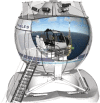Tilt perception is different in the pitch and roll planes in human
- PMID: 36780905
- PMCID: PMC9925277
- DOI: 10.14814/phy2.15374
Tilt perception is different in the pitch and roll planes in human
Abstract
Neurophysiological tests probing the vestibulo-ocular, colic and spinal pathways are the gold standard to evaluate the vestibular system in clinics. In contrast, vestibular perception is rarely tested despite its potential usefulness in professional training and for the longitudinal follow-up of professionals dealing with complex man-machine interfaces, such as aircraft pilots. This is explored here using a helicopter flight simulator to probe the vestibular perception of pilots. The vestibular perception of nine professional helicopter pilots was tested using a full flight helicopter simulator. The cabin was tilted six times in roll and six times in pitch (-15°, -10°, -5°, 5°, 10° and 15°) while the pilots had no visual cue. The velocities of the outbound displacement of the cabin were kept below the threshold of the semicircular canal perception. After the completion of each movement, the pilots were asked to put the cabin back in the horizontal plane (still without visual cues). The order of the 12 trials was randomized with two additional control trials where the cabin stayed in the horizontal plane but rotated in yaw (-10° and +10°). Pilots were significantly more precise in roll (average error in roll: 1.15 ± 0.67°) than in pitch (average error in pitch: 2.89 ± 1.06°) (Wilcoxon signed-rank test: p < 0.01). However, we did not find a significant difference either between left and right roll tilts (p = 0.51) or between forward and backward pitch tilts (p = 0.59). Furthermore, we found that the accuracies were significantly biased with respect to the initial tilt. The greater the initial tilt was, the less precise the pilots were, although maintaining the direction of the tilt, meaning that the error can be expressed as a vestibular error gain in the ability to perceive the modification in the orientation. This significant result was found in both roll (Friedman test: p < 0.01) and pitch (p < 0.001). However, the pitch trend error was more prominent (gain = 0.77 vs gain = 0.93) than roll. This study is a first step in the determination of the perceptive-motor profile of pilots, which could be of major use for their training and their longitudinal follow-up. A similar protocol may also be useful in clinics to monitor the aging process of the otolith system with a simplified testing device.
Keywords: full flight simulator; motion perception; otoliths; perceptual threshold; pilot; semicircular canal; vestibular perception.
© 2023 The Authors. Physiological Reports published by Wiley Periodicals LLC on behalf of The Physiological Society and the American Physiological Society.
Conflict of interest statement
The authors report that they studied the pilots of a flight simulator rendered available by Thales, which is also the employer of two of the co‐authors of the study: D. Keriven Serpollet and Y. James.
Figures





References
-
- Agrawal, Y. , Carey, J. P. , Della Santina, C. C. , Schubert, M. C. , & Minor, L. B. (2009). Disorders of balance and vestibular function in US adults: Data from the National Health and nutrition examination survey, 2001‐2004. Archives of Internal Medicine, 169(10), 938–944. - PubMed
-
- Benson, A. J. (1990). Sensory functions and limitations of the vestibular system. In Warren R., & Wertheim A. H. (Eds.), The Perception and Control of Self‐Motion (pp.145–170). Lawrence Erlbaum Associates.
-
- Benson, A. J. , Spencer, M. B. , & Stott, J. R. (1986). Thresholds for the detection of the direction of whole‐body, linear movement in the horizontal plane. Aviation, Space, and Environmental Medicine, 57, 1088–1096. - PubMed
-
- Bergmann, J. , Bardins, S. , Prawitz, C. , Keywan, A. , MacNeilage, P. , & Jahn, K. (2020). Perception of postural verticality in roll and pitch while sitting and standing in healthy subjects. Neuroscience Letters, 730, 135055. - PubMed
Publication types
MeSH terms
LinkOut - more resources
Full Text Sources

